Intel Cascade Lake Side Channel Mitigations
As an organization, Intel has inertia. Inertia in the form of always adding cores and features in new generations. In this generation, since Intel is not adding cores, what it is doing is mitigating impacts.
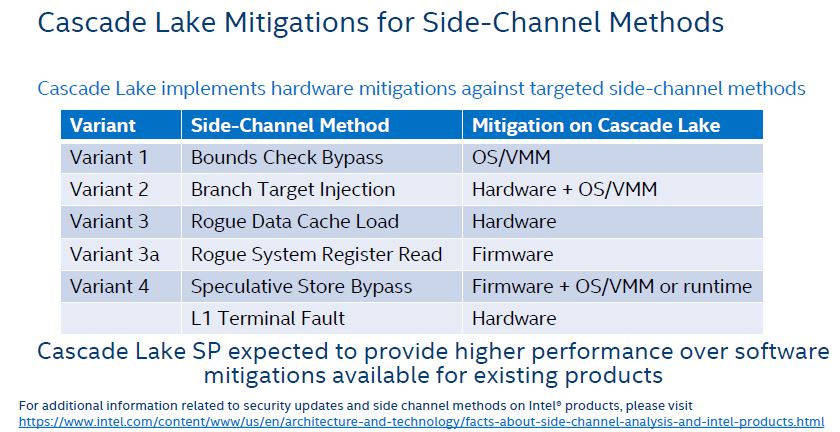
Note, the original version of this slide you may have seen online did not have L1TF. I asked Akhilesh about L1TF during Hot Chips and at some point, it made it into his presentation. That may have been due to the timing of the disclosure and initial presentation submission dates. L1TF is a major impact if an organization needs to turn off Hyper Threading as we covered in Intel Publishes L1TF and Foreshadow Performance Impacts and Foreshadow Flaw Targets Intel SGX and Virtual Machines. It is good to see that it is receiving a hardware mitigation along with Variant 2/3. Still, this means Cascade Lake is not the generation that Intel completely solves a next-generation branch prediction feature.
Like a Phoenix, Intel VNNI Reborn
Cascade Lake-SP VNNI is the new instruction. We first saw VNNI with Intel Xeon Phi Knights Mill for Machine Learning, an HPC chip that was canceled as the mainstream Xeon CPUs gained instructions of the former HPC parts.
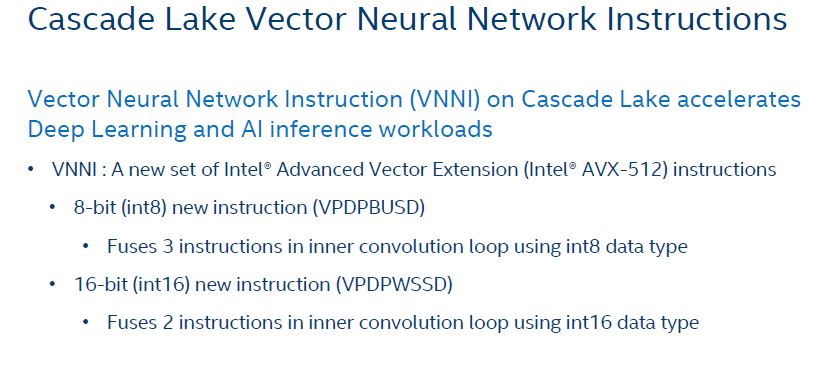
Here is the INT16 version of VNNI:
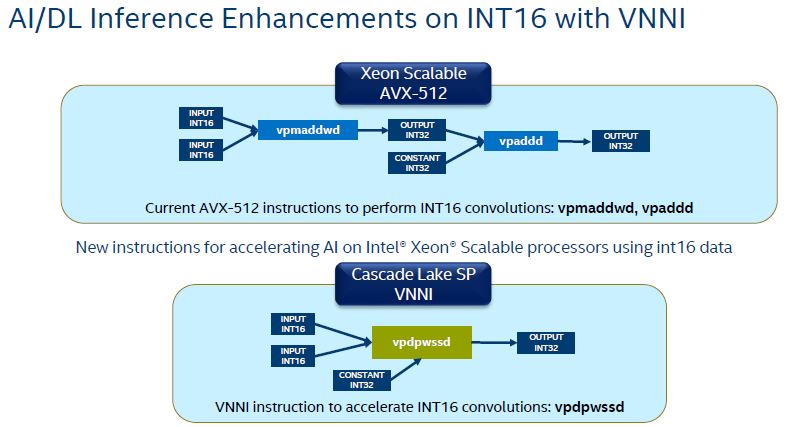
Here is the INT8 version. Like traditional FMA, this is another instruction that allows fewer clock cycles per operation and therefore more performance.
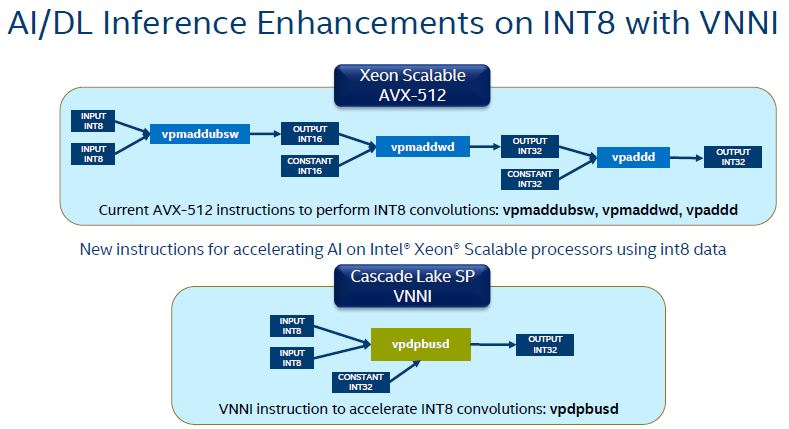
We asked about performance. We expect VNNI to operate alongside AVX-512 clock curves. We also expect AVX-512 floating point and VNNI execution to be different than Knights Landing/ Mill insofar as a customer will have access to performant versions of both instructions.
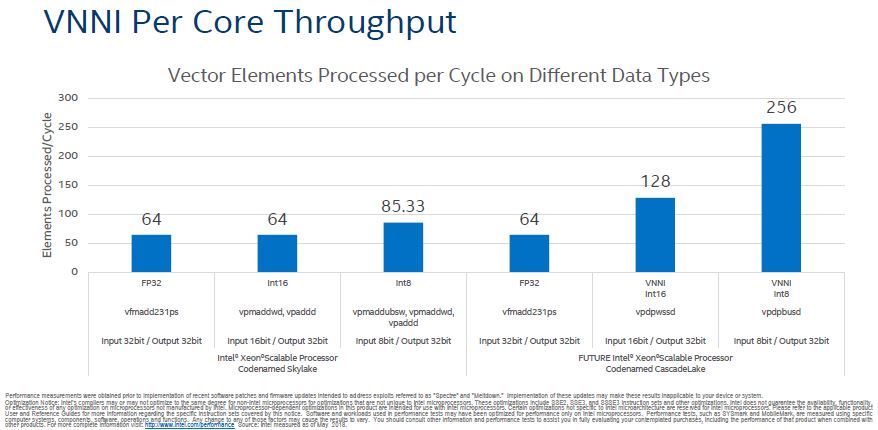
Intel highlighted that for INT8 and INT16 operations, VNNI will greatly accelerate performance. This, combined with Intel’s investment in software, Intel hopes to provide a simple value proposition: you do not need a low power GPU. If you are going to install Cascade Lake CPUs, you can use VNNI for inferencing and do “fast enough” inferencing without adding different hardware.
Cascade Lake-SP’s Big Feature Optane Persistent Memory Support
The most anticipated feature of Cascade Lake-SP is support for Intel Optane DC Persistent Memory. Optane Persistent Memory puts Optane in a DDR4 DIMM package and allows high capacity persistent memory directly attached to DDR4 controllers instead of through the PCIe bus.
Much of the Hot Chips 30 presentation was focused on information we have already covered in Intel Optane DC Persistent Memory Sampling Today Revenue Delivery 2018 and Intel Data-Centric Innovation Summit Cascade Lake Optane and More. Check those for a refresher.
The actual hardware interface is DDR4 electrical and physical. Intel confirmed capacity details we published in our earlier piece Next-Gen Intel Cascade Lake 28C Supporting 3.84TB Memory.
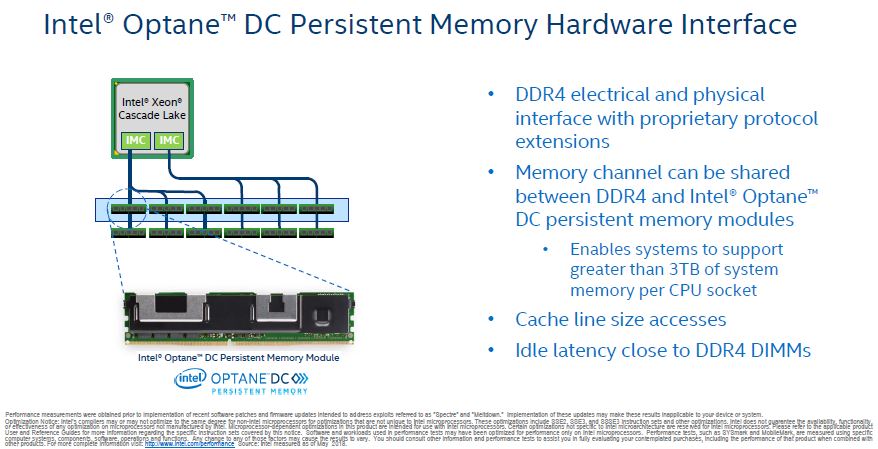
The company also focused on the persistence domain. This is important because the software needs to know when data becomes persistent much like an acknowledge in traditional disk/ SSD storage.
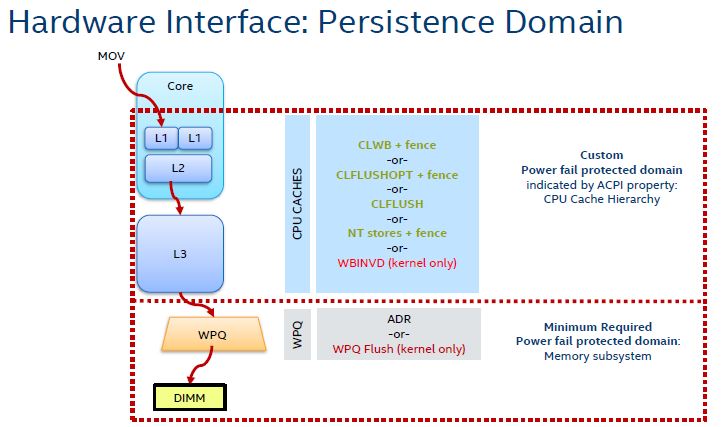
If you are a software developer, get a Cascade Lake box with Optane Persistent Memory as soon as possible. The ability to integrate OPM is the killer tech of this generation.




OPMoF ???
Optane Persistent Memory over Fabrics. Need to be extra trendy!
This kind of sounds goodbye Xeon, hello EPYC2.
I thought this was going to be an Intel bashing piece but it really isn’t. You did a good job presenting the new parts first. I’ll agree that this isn’t going to keep everyone who is going epyc to stay Intel. Intel knows that too unless they know of some major security issue that’s not public yet and cascade fixes but amd can’t handle.
The Meltdown mitigation alone might be worth quite a lot in Performance for I/O heavy applications, and this is an area where the MCM Design of AMD is problematic. It’s going to be interesting to see if AMD manages to put more Cores on a die and perhaps also attach more memory channels and PCIe lanes, this would seriously diminish the last of Intels advantages.
Do i need a new motherboard when upgrading from Skylake Xeons to Cascade Lake xeons?? Would like to get a new Skylake Xeon SP motherboard (Supermicro, Tyan ??) and upgrade approx a year from now to Cascade Lake. The only thing keeping me from going Epyc is the Optane Persistent Memory feature…looks great for a fast OLTP sql database that fits within 4-8 TB…
Cascade Lake will use the same motherboards and chipsets with a BIOS update
It is going to take a while for IT Departments to adopt amd epyc. especially mission critical 24x7x365 operations to switch to a relatively new platform, from a company that has a less then stellar data center reputation. Core counts aren’t everything especially given certain software is licensed per CORE. So by Intel pushing forward and integrating new features and fixes that will filter in as IT Dept refresh cycles hit, this is a good. It would have been bad had they not introduced a refresh this year.
Totally agree with you Matthew, Intel has a stellar reputation these days, the leaks are all over the place, there have neverbeen more hacks on mission critical operations the last year and a half then ever before.
There have never been more speed decrease in a processor because of all the patches than ever bevor.
8 socket 28 cores is no problem with licenses per CORE, but 2 socket 32 cores is becomming a real problem and why do people need all those PCIe lanes anyway.
AMD are no saints but doing a pretty good job lately.
As EPYC has been mentioned a couple of times, while interested in it depending on your environment it may not be an option. While EPYC may be cheaper and faster, it also has higher power demands which could be a limitation for some.
“Just about everyone in the industry thinks that Intel Optane Persistent Memory (OPM) is going to be big.”
This is absolutely HILARIOUS with years of hindsight.